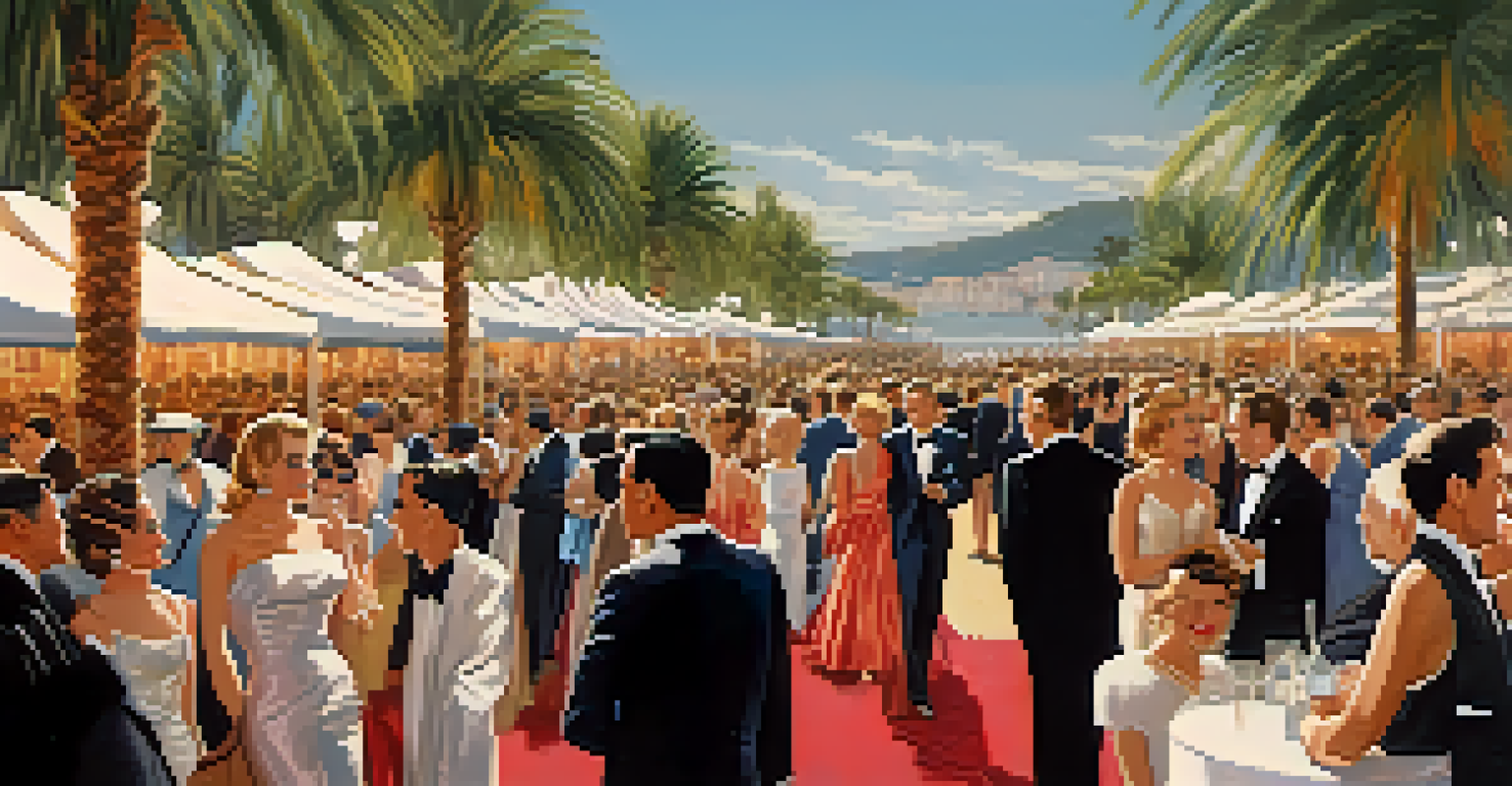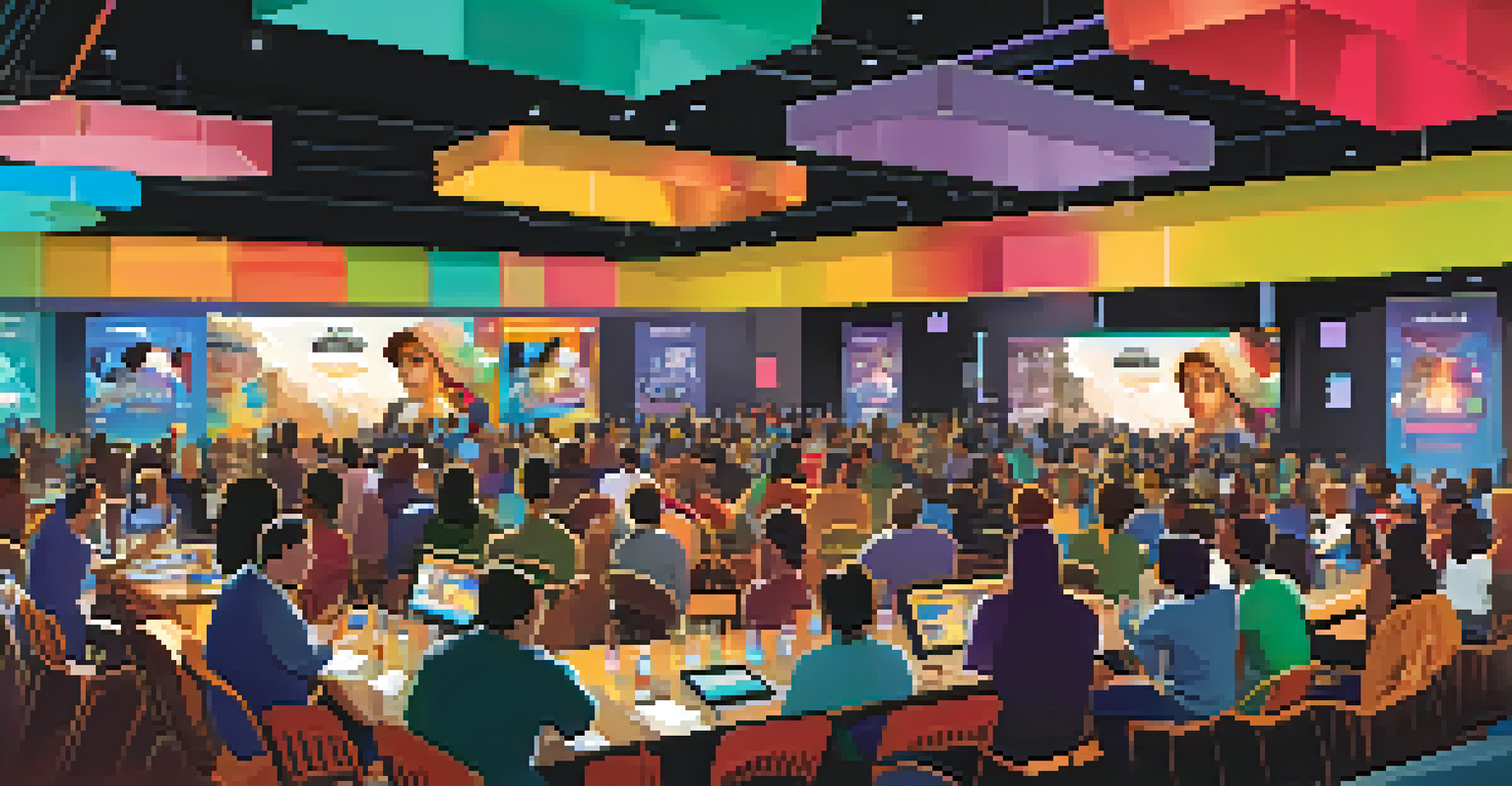The Evolution of Film Festivals: A Historical Perspective

Origins of Film Festivals: Birth of a New Cinematic Era
Film festivals began in the early 20th century, with the first notable event being the Venice Film Festival in 1932. This festival aimed to promote Italian cinema and showcase international films amidst a backdrop of political tension in Europe. As the art of filmmaking evolved, so did the need for a platform to celebrate it.
Film festivals are a celebration of cinema, a chance for filmmakers to showcase their creativity and connect with audiences.
Initially, these festivals were modest gatherings focused on a few films, but they quickly grew into major cultural events. They attracted filmmakers, critics, and audiences eager to connect with the art form. This early period set the stage for what was to come, as more festivals began to sprout worldwide.
The establishment of film festivals was a response to the desire for cultural exchange and artistic appreciation. They provided filmmakers with a unique opportunity to showcase their work in front of discerning audiences, paving the way for future cinematic movements and trends.
The Rise of International Film Festivals in the 1950s
The 1950s marked a pivotal moment in the evolution of film festivals, as events like Cannes and Berlin emerged as influential platforms. These festivals not only celebrated cinema but also fostered international collaboration and competition among filmmakers. The glitz and glamour of Cannes, for instance, attracted major stars and directors, further elevating the festival’s profile.

During this time, the concept of the 'film festival circuit' began to take shape, where filmmakers would submit their works to multiple festivals to gain exposure. This interconnectedness allowed for a more diverse range of films to be showcased, giving rise to new genres and styles that challenged traditional norms.
Film Festivals: A Cultural Evolution
Film festivals have transformed from modest gatherings into major cultural events that celebrate diversity and innovation in cinema.
The 1950s also highlighted the political undertones of film festivals, as many films presented were reflections of societal issues. This focus on global narratives not only enriched the cinematic landscape but also sparked dialogues that resonated far beyond the screens.
The 1960s and 1970s: Festivals as Platforms for Counterculture
In the 1960s and 1970s, film festivals became hotbeds for countercultural movements. As filmmakers began to explore unconventional storytelling techniques and social commentary, festivals provided them with a supportive environment to share their vision. Events like the New York Film Festival became synonymous with avant-garde cinema and experimental films.
The festival circuit is a way for independent filmmakers to gain exposure and recognition in a competitive industry.
This era saw the rise of independent filmmakers who used festivals to break away from Hollywood's constraints. Films that challenged the status quo often found their footing at these events, gradually gaining recognition and paving paths for indie cinema. It was a time when creativity flourished, and audiences were eager for fresh perspectives.
Moreover, the impact of the political climate during these decades influenced the types of films showcased. From protests against the Vietnam War to movements advocating for civil rights, film festivals became a platform for voices that needed to be heard, forever changing the cinematic narrative.
The Digital Revolution: Changes in Film Festivals in the 1990s
The 1990s ushered in the digital revolution, which had a profound impact on film festivals. With the advent of digital filmmaking, creating and distributing films became more accessible than ever. This democratization of the medium allowed a surge of new voices and stories to emerge, which festivals eagerly embraced.
During this period, festivals like Sundance gained prominence, emphasizing independent films and showcasing diverse narratives. The increased visibility of indie films at major festivals highlighted the shift in audience preferences, as viewers sought authenticity over traditional blockbuster fare.
Impact of Digital Revolution
The 1990s digital revolution democratized filmmaking, allowing independent voices to flourish and reshaping audience preferences towards authenticity.
The digital age also introduced new challenges, particularly around distribution and audience engagement. Festivals began to experiment with online screenings and digital platforms, paving the way for a hybrid model that continues to evolve today.
Globalization of Film Festivals in the 2000s
In the 2000s, the globalization of film festivals became apparent as more countries established their own events. Festivals like Tribeca and Toronto International Film Festival gained international recognition, making them key players in the global cinematic landscape. This globalization allowed for a rich exchange of ideas and cultures through film.
As filmmakers and audiences from different backgrounds interacted, the diversity of stories showcased at festivals expanded significantly. This era saw a rise in films from underrepresented regions, shedding light on unique perspectives and experiences that were previously overlooked.
The growing importance of networking at these festivals became a focus, as filmmakers sought to connect with distributors and industry professionals. This not only helped independent films find their audience but also contributed to the thriving global film market we see today.
Film Festivals Today: Embracing Innovation and Inclusivity
Today, film festivals have evolved into dynamic platforms that embrace innovation and inclusivity. Many festivals are integrating technology, such as virtual reality and interactive storytelling, to engage audiences in new ways. This adaptability allows festivals to remain relevant in a rapidly changing entertainment landscape.
Inclusivity has become a central theme, with many festivals actively promoting diversity among filmmakers and genres. Initiatives aimed at supporting underrepresented voices are now commonplace, ensuring that a broader range of stories is told and celebrated on these stages.
Future Trends in Film Festivals
As film festivals embrace sustainability and adapt to the rise of streaming, they continue to be vital cultural touchstones that inspire and challenge audiences.
Furthermore, the rise of social media has transformed how festivals connect with audiences. Filmmakers can now engage directly with viewers online, creating communities that extend far beyond festival dates. This interconnectedness enriches the cinematic experience and highlights the importance of audience participation.
The Future of Film Festivals: Trends and Predictions
Looking ahead, the future of film festivals is poised for exciting transformations. As environmental sustainability becomes a pressing global issue, many festivals are adopting eco-friendly practices. This shift not only reflects a commitment to the planet but also resonates with audiences who prioritize sustainability in their choices.
Moreover, the continued rise of streaming platforms is likely to influence the festival landscape. With more films being released directly through digital channels, festivals may redefine their role, focusing on creating unique experiences that cannot be replicated online. This could lead to a resurgence of the communal viewing experience that festivals foster.

As film festivals adapt to these changes, one thing remains clear: they will continue to serve as vital cultural touchstones. They will not only celebrate the art of filmmaking but also foster conversations that challenge and inspire audiences for generations to come.